Sunflowers (Helianthus annuus) live up to their name as they reach for the sun on long summer days. This activity is called heliotropism, and it simply means to follow the sun. According to the National Sunflower Association, sunflowers have been around for thousands of years, and are native to North America. They date back to 3000 BC, where they were cultivated in what is now known as Arizona and New Mexico.
In addition to being known for their stunning beauty, sunflower seeds were eaten and used to make oil, and their sturdy stalks were used as material for building purposes. Spanish explorers took the plant back to Europe, where it spread across the continent to Russia. Many hybrids were created, giving us a variety of gorgeous blooms to admire.
With bright yellow petals and dark centers, sunflowers make lovely additions to any flower garden. They are tolerant of heat and they are versatile, meaning just about anyone can grow them. An all-tine favorite, they are able to survive in USDA hardiness zones 2 through 11 (via HGTV). Finally, they are not toxic to humans, cats, dogs, or even horses (via The Spruce).
How to use sunflowers in garden
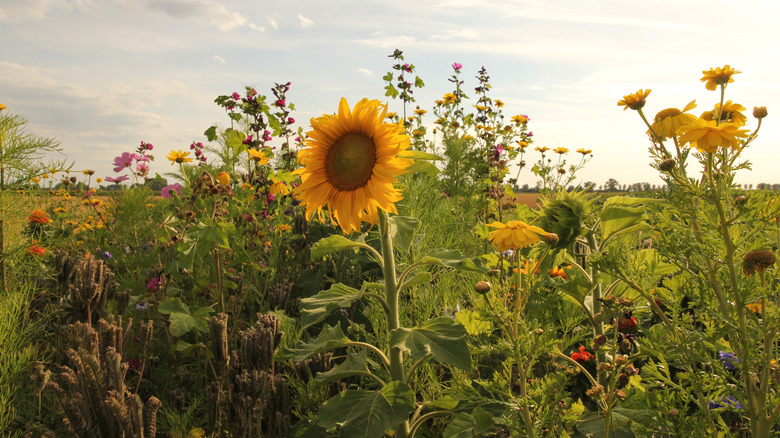
Sunflowers look glorious in your flower garden or vegetable garden. For your vegetable garden, SF Gate suggests planting them on the northern side so they won’t cover your other vegetables with too much shade. Place them along the border, and leave about 3 inches between them and the next row of plants. Companion plants such peas, lettuce, and nasturtiums are good choices, just remember to leave each plant enough room to grow. Sunflowers also provide support for trailing plants, such as cucumbers and green beans. They can also attract pollinators, so it’s good to place them around plants that need pollination, such as zucchini and squash.
Some plants don’t do well with sunflowers as neighbors because sunflowers release a toxin that may damage other plants, affecting how they grow. Your pole beans and Irish potatoes will fare better if they are not near sunflowers, per Garden Guides.
How to grow sunflowers
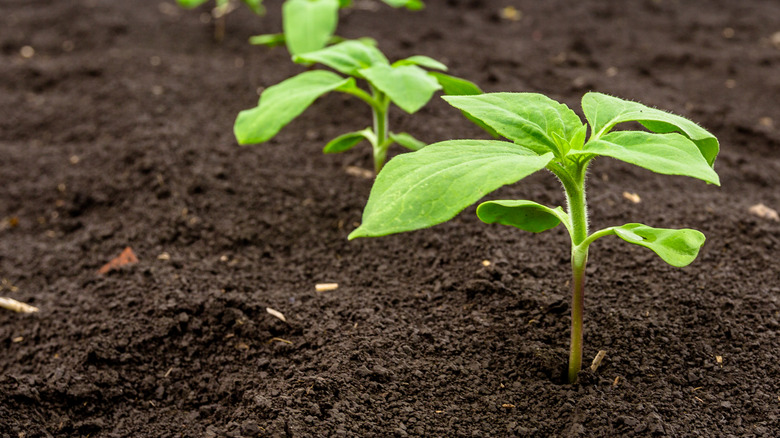
Growing sunflowers from seeds is easy and actually recommended by HGTV because you can grow the specific varieties you want. Furthermore, they do not tolerate it well when their roots are disturbed, per Almanac. When planting from seed, put them in the ground after the last frost when the soil is about 60 degrees. Place seeds about 1/2 inch deep in the soil about 6 to 12 inches apart. Water seedlings well about 4 inches from the roots and do so plentifully when the plant becomes taller and stronger.
If you want blooms that last all summer long, plant a new row of seeds every few weeks. Depending on the type of sunflower you plant, you could see blooms as early as 80 days. Wherever you plant them, make sure they will get plenty of sun, as they need at least six to eight hours of full sun every day.
How to care for sunflowers
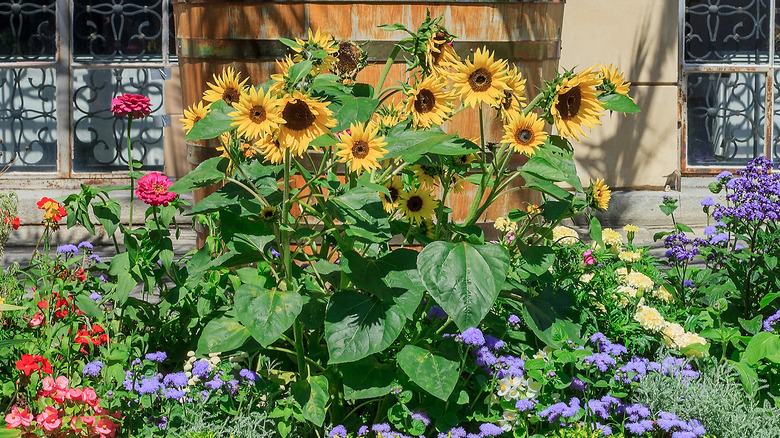
Christopher R Kirkland/Shutterstock
Caring for sunflowers is relatively easy, as they can tolerate periods of drought. Their roots can reach as far as 2 feet down and 3 feet across, which is why they can go for periods without water. Sunflowers also aren’t picky about the kind of soil they need, but they do better in soil that is slightly acidic. Known for being heavy feeders, sunflowers also need a soil that contains some nutrients. For this reason, HGTV recommends planting them in a location where the soil is loose and drains well. Topping soil with mulch will help regulate soil temperatures as well as keep it moist in summer heat, per Gardenia.
If you are growing tall sunflowers, plant them in a location that offers protection from the wind, such as alongside a fence or near the side of a building. In addition, tall varieties may need a stake or some kind of support for their stems until they become strong enough to stand on their own (via Almanac).
Sunflower varieties
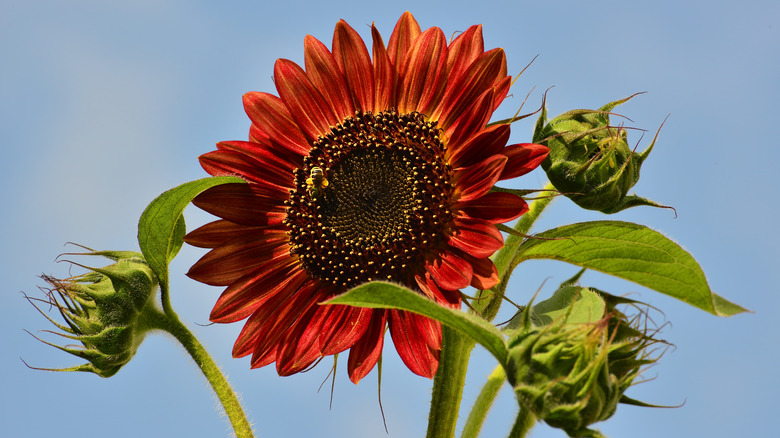
The Old Major/Shutterstock
Sunflowers generally fall into three varieties, based on their size; you can choose from dozens of giant, medium, and dwarf types. Giant varieties can grow taller than fences, and will generally need stakes to keep then from bending over or breaking in the wind. Medium types still get tall, but not as tall as giants, and dwarf sunflowers are best for smaller spaces, per Gardening Know How.
- American Giant Sunflowers (Helianthus annuus “American Giant”) have thick stems and can grow up to 15 feet tall.
- Skyscraper sunflowers (Helianthus x laetiflorus) can reach as high as 12 to 14 feet tall.
- Helianthus annuus “Russian Mammoth” sunflowers can grow up to 12 feet tall.
- For striking blooms with reddish petals, try Helianthus annuus “Moulin Rouge” sunflowers.
- Dwarf varieties include Helianthus annuus “Little Becka,” “Sunny Smile,” and “Teddy Bear.”
- If you want pollen-free varieties to use in bouquets, try “Jade” and “Strawberry Blonde” types.
Growing sunflowers in a pot
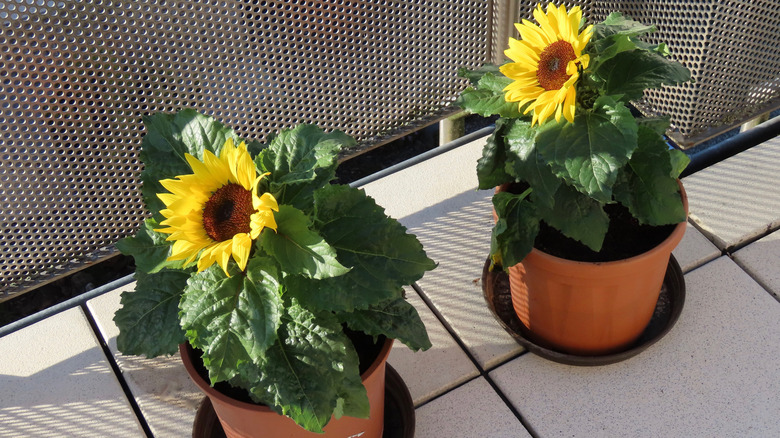
Ilona Lablaika/Shutterstock
Since most types of sunflowers grow tall and have long root systems, growing them in a small pot might be challenging. That being said, shorter varieties do well in smaller areas and pots. The best types of sunflowers to grow in pots are dwarf and branching varieties because rather than producing a single bloom atop a stem, they provide many blooms. Horticulture Magazine suggests Dwarf Sunspot, Suntastic, Little Leo, Teddy Bear, Big Smile, and Pacino Gold as types to grow in containers.
Sow seeds in small containers and transplant when they are a few inches tall. A biodegradable starter container is best because it will help reduce any root damage during the transplanting stage. Repot seedlings in a container that has drainage holes using a multi-purpose potting soil that is peat-free. Move the plants outside when there is not danger of frost or keep them inside in a location that gets plenty of sun.
How to fertilize sunflowers

Sergiy Bykhunenko/Shutterstock
Since sunflowers can adapt to their surroundings, they do not depend on fertilization. According to Gardening Know How, most types of garden soil have enough nutrients for sunflowers. Keeping an eye on how your plants look as well as how much they bloom can be a good gauge as to whether you need to fertilize them (via SF Gate). That being said, nitrogen encourages growth. If you add nitrogen, pay attention to how your plants respond to avoid over-fertilization because too much can hinder blooms. Moreover, too much fertilizer can cause stem breakage, per Almanac.
If you use fertilizer, don’t apply it directly to the base of the plant because it could damage it. To avoid splashing fertilizer on the stems, Almanac recommends building a small moat around the base of the plants. As an alternative, Gardening Know How recommends a slow-release fertilizer that you mix with the soil around the base of the plant.
Harvesting sunflower seeds
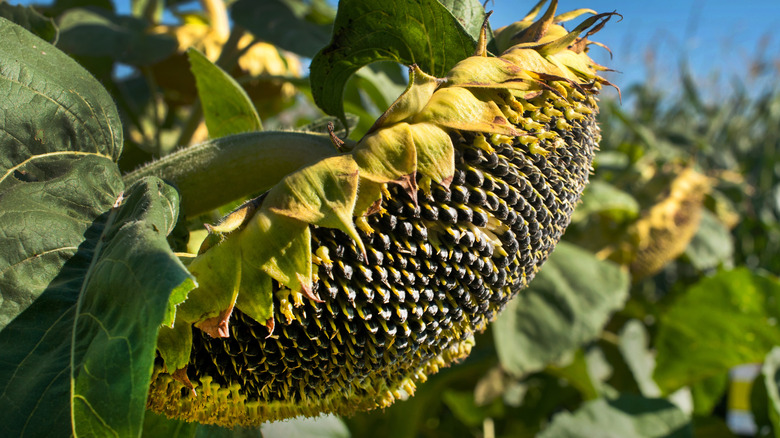
Pavlo Baliukh/Shutterstock
Harvesting sunflower seeds is a way to collect a treat at the end of the summer when the heads of the flowers to dry out. You will know when this begins to occur because the back of the flower head will turn brown, and the petals begin to wilt. At this point, the seeds will swell and loosen up. You may want to protect the heads of the flowers with cheesecloth or a similar fabric to keep critters from getting to the seeds while you wait to remove the heads.
Remove the head and place it on a flat surface. To remove the seeds, simply rub your hand over the head of the flower. You can also hang the heads upside down in a safe place free from critters. Rinse thoroughly and lay them on a flat surface, then allow them to dry before removing the seeds, per Almanac.
Troubleshooting sunflowers
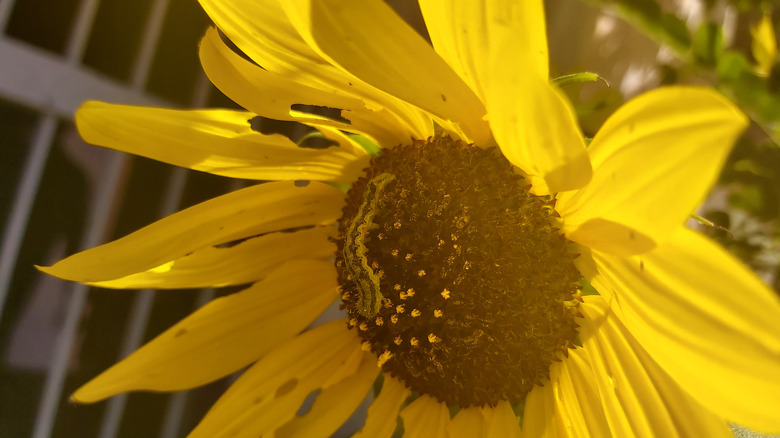
kk Zumbul/Shutterstock
Insects aren’t usually a problem with sunflowers, but that’s not to say they don’t exist. According to Gardening Know How, moths may do the most harm by laying their eggs in the flowers. When the eggs hatch, they feed on the flower heads. Additionally, sunflower beetles and cutworms can eat the leaves of smaller plants, which can result in damaged or destroyed plants. Borers, as the name suggests, bore their way into the stems of sunflower plants and kill them. Grasshoppers and some caterpillars like to eat the leaves of the plants and are only a problem in large numbers. The best way to avoid any problems is to treat with insecticides for sunflowers.
When it comes to diseases, powdery mildew, downy mildew, and rust might show up on some sunflower leaves. If you see any signs, Almanac recommends using garden fungicide sprays. When seeds begin to emerge from the heads, squirrels, chipmunks, deer, and birds might show an interest. Covering heads with cheesecloth generally prevents critters from nibbling on them.




